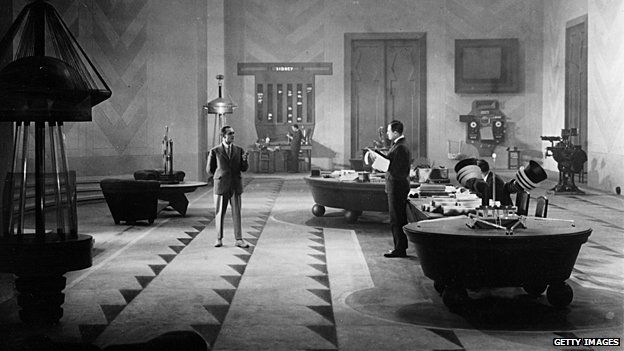Movable type: The brave new world of office computing
- Published

You might be reading this on a work computer.
And chances are, that computer - and its word processor, spreadsheet, and browser - pretty startlingly resembles its ancestor way back in 1995.
Yes, Clippy, Microsoft Office 1997's celebrity paperclip, is gone.
Things are quicker too, with more storage.
Still, the similarity to two decades ago is uncanny.
Take someone from 1995, deposit them in front of today's keyboard, and they could pretty much get on with it.
A minor letdown, when you ponder how far we've come since 1975.
But as we grow used to more mobility and to bringing along our own devices, might the stodgy workplace computer at last totter on the precipice of change?
Two-in-one tablets like the Surface 3, with its ultra-thin keyboard cover, finally resemble substitutes for notebooks.
Microsoft touts its Windows 10, due in a few months, as the Bring Your Own Device (BYOD) Windows, geared to interface with tablets and smartphones running other operating systems.
With developments in consumer electronics, it is now common for people to own better devices than those at work, says Marta Fiorentini, a senior research analyst at the International Data Corporation.
"Sandboxing" work and personal data in different compartments is removing some security worries, she says.
The end of email might be glimpsable, too - its formal, asynchronous, spammy nature grating millennials who would rather use something nearer Facebook.
Businesses are sending "upwards of 108 billion emails a day and people just can't keep up," says Jeff Schick, IBM's general manager of enterprise social solutions.
French IT company Atos went so far as to ban it internally, in 2012.
Death of the desktop?
"For me the desktop won't exist, the physical PC - why would it?" says Mark Corley, chief technology officer at Avanade, a joint venture of Microsoft and Accenture.
You certainly wouldn't design it from scratch, now.
Your work and data already follow you on the cloud. Cloud applications are demonstrably cheaper to run, too.
And your computer processing speed may be overkill for 90% of your tasks, says Mr Corley, while woefully insufficient for the remainder.
But thin clients more like terminals, perhaps responding to a user's biometric log-in, can draw on appropriate amounts of processing power, and customised settings, both stored elsewhere.
"What's the point of having this box that sucks and creates dust," asks Mr Corley, "is aged before it runs off the production line, and is from a perspective of computer power, heating, cooling, storage, and everything else about it, just an inefficient clunky box?"
For collaborative environments, you could probably begin with a large video wall or multi-touch whiteboard, he says.
In 2012, Microsoft acquired Perceptive Pixel, a start-up specialising in multi-touch interfaces.
This January it announced Surface Hub, a combination videoconferencing system and cloud-enabled whiteboard.
The Equil Smartmarker takes a different approach, using an ordinary dry-erase marker, equipped with a bluetooth holder to transmit your scribbles.
Better speech recognition, like Dragon NaturallySpeaking or Microsoft's neural-net system MAVIS, could figure heavily in the future work computer, too, transcribing conversations and filing them away for future reference.
And to knit together teams in different bits of the world, some offices have installed a video wall down one end, with a FaceTime or Skype connection.
As costs come down, this becomes easier to do.
Meanwhile in the more distant future, virtual-reality tech, similar to Oculus Rift's head-mounted display, might oust Skype conference calls for employees growing more dispersed geographically.
Google Glass, HTV Vive, and Samsung Gear all scamper at different speeds from the drawing board to the market.
And in another decade's time, machine learning might be just advanced enough to write for us, in a style based on our best work, making us sound articulate and intelligent when we're still fumbling for the coffee.
Not a cloud in sight
Small and medium enterprises, and sectors like the media, have been the fastest adopters of the cloud, says Paul Willmott, global leader of McKinsey Digital.
But with corporations in more traditional sectors, there are more likely to be legacy systems, even dating to the 1950s and 1960s complete with green screens.
The further a workplace ventures beyond a word processor and browser, the more likely its workers will be deeply frustrated with their desktop experience, says Mr Willmott.
And many corporations are struggling with the cloud full stop, he adds.
The Snowden disclosures of widespread government hacking only added to many large corporations' paranoia about information security.
Meanwhile we all bring into work expectations for intuitive, functional applications and websites, from dealing with Uber, Amazon, and eBay.
One result has been Bring Your Own App (BYOA).
Generation Y and millennials, when they don't like what they find in the workplace, simply source something off the internet and share it with colleagues.
The only way to see which ones work is, after all, to try them.
And it is a trend corporations will have to grow used to.
According to an article published this week in the Harvard Business Review, machine learning has reached the point where it can have a first go at many sorts of tasks, and delegate particularly thorny ones to human employees.
One platform, WorkFusion, breaks data work into tasks, and assigns them algorithmically to human and computer resources.
Nuance's virtual agent, VirtuOz, answers 80 to 90% of customers' questions, but is programmed to learn when users become upset, and pass the query to a human agent.
So the office of the future may increasingly have artificial intelligence algorithms calling the shots, or at least divvying up the tasks.
Machines as managers might take getting used to.
But somebody had to turn off Facebook for us.